Three New and Two New Record Species of the Genus Dichaetomyia Malloch (Diptera: Muscidae) from China †
Abstract
1. Introduction
2. Materials and Methods
3. Results
3.1. Taxonomy
Treatment of Species
- Dichaetomyia villscutellata sp. n.
- Dichaetomyia bimaculata sp. n.
- Dichaetomyia maculiventra sp. n.
- Dichaetomyia varicauda Emden, 1965
- Dichaetomyia latistriata Malloch, 1924
3.2. Key to the Species
- Key to Chinese species of genus Dichaetomyia Malloch, 1921 (males)
| 1. Post-dc 4 ......................................................................................................................................2 |
| - Post-dc 3 ........................................................................................................................................6 |
| 2. Margin of lower lateral scutellum with flat hairs or ventral surface of scutellum with hairs..................................................................................................................................................3 |
| - Margin of lower lateral scutellum without flat hairs; ventral surface of scutellum bare...................................................................................................................................................5 |
| 3. Abdomen entirely yellow; antennae brownish-yellow and palpi dark brown.................. |
| ........................................................................................................................D. villscutellata sp. n. |
| - Abdomen base black...................................................................................................................4 |
| 4. Lower stpl markedly closer to posterior than to anterior stpl; meron with hairs nearby the posterior spiracle; both post pronotal lobe and halter tawny; leg entirely yellow except black-brown tarsi; fore tibia without median p; hind tibia without pd; thorax with thick grey-brown pruinosity.....................................................................D. keiseri Emden 1965 |
| - Lower stpl equidistant from anterior and posterior ones; meron without hairs; post pronotal lobe yellow; halter brown; at least basal part of femur dark; tibia and tarsi yellow; fore tibia with one median p; hind tibia with 1–3 pd; thorax with thin greyish-brown pruinosity......................................................................................................D. pallitarsis (Stein,1909) |
| 5. Tergites 4 and 5 dark brown, slightly darker than the ones before; tergite 5 with thin pruinosity ....................................................................................... D. quadrata (Wiedemann, 1824) |
| - Tergite 5 and posterior part of tergite 4 black, shining, and without pruinosity.................... |
| ............................................................................................................. D. monticola Emden, 1965 |
| 6. Postpedicel about 8 times as long as pedicel, exceeding upper half of eyes; light yellow, exceeding lower margin of eyes; legs yellow except tarsi brown................................................. |
| ............................................................................................................... D. antennata (Stein, 1918) |
| - Postpedicel almost 5 times as long as pedicel, not exceeding lower margin of eyes .....................7 |
| 7. Scutellum with lower margin laterally with flat or curved black hairs, ventrally with upright cilia ...................................................................................................................................8 |
| - Scutellum with its lower margin bare ....................................................................................12 |
| 8. Scutellum ventrally with yellow upright hairs distally; its lower margin laterally with pale thin hairs (sometimes only a few) ......................................................................................9 |
| - Scutellum without upright hairs distally; its lower margin laterally with many flat or curved, black hairs .....................................................................................................................10 |
| 9. Body dark black; abdomen always olive, with metallic luster; more yellowish in the lower areas, sometimes with femur yellow; palpus dark brown; end of M1 upcurved distinctly; coxae brown; hind tibia with two strong ad ..................... D. bibax (Wiedemann, 1830) |
| - Body brownish yellow mostly; abdomen reddish brown or orange; middle part of scutum dark; palpus yellow; end of M1 straight; coxae greyish white; hind tibia only with one ad ..........................................................................................................D. flavipalpis (Stein, 1915) |
| 10. Katepimeron with hairs; frons as wide as anterior ocellus; hind femur pv longer than the maximum breadth of the femur; tergites 4 and 5 black, but tergite 5 with orange margin ....................................................................................................D. aureomarginata Emden, 1965 |
| - Katepimeron bare.....................................................................................................................11 |
| 11. Frons narrow, only 0.5 as wide as antenna at the most; hind femur pv equal to the longest diameter of femur; abdomen entirely yellowish brown .............................................. |
| .......................................................................................................D. luteiventris (Rondani, 1873) |
| -Frons broad, about 2 times as wide as antenna; hind femur pv less than half as broad as femur; syntergite 1 and 2 brownish yellow; tergite 3 dark brown; tergites 4 and 5 black ............. |
| .....................................................................................................D. latiorbitalis Xue and Wei, 1998 |
| 12. Eyes with long, dense hairs; antenna dark brown; postgena with a few pale hairs; anatergite bare......................................................................... D. dasiomma Xue and Kano, 1994 |
| - Eyes bare or with few short and scattered hairs..................................................................13 |
| 13. Palpus orange or yellow at least at apex ...........................................................................14 |
| - Palpus entirely dark.................................................................................................................26 |
| 14. Palpus yellow at apex...........................................................................................................15 |
| - Palpus entirely orange or yellow to light yellow.................................................................18 |
| 15. Antenna dark brown; postalar wall bare or with fine hairs; lower occiput hairs entirely black; mid femur basal 3/5 with dense pv; longest shorter than segment width; subapical ad usually 1; hind tibia without pd…......................…D. fulvoapicata Emden, 1965 |
| - Antenna yellow; postalar wall with hairs…………......................................................……16 |
| 16. Lower occiput hairs black; abdomen yellow; tergites 3, 4, and 5 with long triangular median vittae; tergites 3 and 4 with semicircular lateral spots........................................................ |
| .......................................................................................................................D. maculiventra sp. n. |
| - Lower occiput hairs yellow; abdomen mostly dark brown with yellow base………...17 |
| 17. Katepimeron with hairs; scutum with two black vittae (inner ones inconspicuous); median vitta with brown pruinosity; the part under marginal scutellar setae with a row of small hairs; hind tibia with two avs…............................................D. declivityata Xue and Lin, 1996 |
| - Katepimeron bare; scutum with four black vittae; median vitta dark brown; the part under marginal scutellar setae bare; hind tibia with three avs…..........D. albiceps (Van der Wulp, 1881) |
| 18. Fore femur anteroventrally with a row of pectinate setae……....................................19 |
| - Fore femur anteroventrally without pectinate setae……….........................….....…..........23 |
| 19. Mid femur anteroventrally with a row of pectinate setae; anterior margin of wing with costal spine; most of abdomen blackish except apices of tergite 4 orange.................... |
| ..............................................................................................................D. setifemur Malloch, 1928 |
| - Mid femur anteroventrally without pectinate setae……............................…….................20 |
| 20. Postalar wall bare; costa ventral surface bare; abdomen except tergites 3, 4, and 5 brownish-black, rest orange-yellow translucent........................D. palpiaurantia Feng, 1999 |
| - Postalar wall with hairs…...……….....................................................…................................21 |
| 21. Hind tibia with one small pd………................................................D. latistriata Malloch.1924 |
| - Hind tibia without pd……………………………………….…...........……..……..................22 |
| 22. Lower occiput hairs yellow; anatergite with hairs; costa ventral surface bare; thorax with four distinct black vittae; tarsi black……………..........……. D. pahangensis Malloch, 1925 |
| - Lower occiput hairs black; anatergite bare; hind femur mostly brown, and tarsi dark brown; abdomen mostly pitch black…………………...................D. nigricauda Emden, 1965 |
| 23. Antenna entirely yellow; thorax dark brown; scutum with four brown stripes; scutellum brownish-yellow, with anterior and posterior spiracles yellow……………........................... |
| ......................................................................................................D. corrugicerca Xue and Liu, 1996 |
| - Postpedicel entirely or mostly brown…........................................………………................24 |
| 24. Anatergite bare; ommatidia on anterior upper part of eyes distinctly enlarged; postalar wall with a few pale hairs; thorax with vittae only up to scutoscutellar suture; abdomen shiny, with thin pruinosity……………………..........……...…… D. heteromma Emden, 1965 |
| - Anatergite with hairs................................................................................…............................25 |
| 25. Antenna dark brown; thorax yellow except first half of scutum, katepisternum and meron black; postalar wall with hairs………..........………..........……… D. sinica Feng, 2003 |
| - Antenna mostly dark brown; base yellow; thorax mostly black; postalar wall bare…...... |
| ................................................................……….........................................…. D. bimaculata sp. n. |
| 26. Fore femur anteroventrally with a row of pectinate setae……......…..........................27 |
| - Fore femur anteroventrally without pectinate setae…….................................……….......30 |
| 27. Mid femur anteroventrally with a row of pectinate setae; each tergite with brown posterior margin; posterior part of tergite 5 with two yellow spots; all tibiae yellow; rest of legs dark brown.................................................................D. biangulata Xue, 1996 |
| - Mid femur anteroventrally without pectinate setae…….....…............................…………28 |
| 28. Hind tibia without pd; thorax brownish yellow; scutum dark brown, with four dark vittae; postpronotal lobe and scutellum yellow; metepisternum bare; radial node and ventral face of basal R4+5 with short setula; sternite 5 slender; legs yellow.................................. |
| ............................................................................................D. jianfenglingensis Xue and Liu, 2011 |
| - Hind tibia with pd ....................................................................................................................29 |
| 29. Hind femur with three pds; legs yellow except tarsi black; postpronotal lobe and scutum not yellow.............................................................................................. D. femorata (Stein, 1915) |
| - Hind femur with one pd; legs yellow except hind tibia dark; postpronotal lobe and scutum yellow............................................................................................ D. pectinipes (Stein, 1909) |
| 30. Dorsal surface of abdomen densely and evenly pruinose, nearer to hair roots pale, with distinct fish-like scales; ommatidia not enlarged; palpus dark brown; vittae of thorax approaching scutoscutellar suture; postalar wall bare.....D. scabipollinosa Xue, 1996 |
| - Dorsal surface of abdomen without or with uneven pruinosity, without any distinct fish-like scales...............................................................................................................................31 |
| 31. Postpedicel entirely or mostly brown……………………….............................................32 |
| - Antenna entirely pale yellow, yellow, or yellowish-brown………………............………35 |
| 32. Postalar wall with hairs; costa ventral surface posterior margin with a few fine pale hairs (different from usual short pubescence); thorax mainly orange, without distinct stripes; hind tibia with small pd; tarsi brown…………....................D. apicallis (Stein, 1904) |
| - Postalar wall bare………….....................………….................................................…………33 |
| 33. Tegula blackish brown; thorax brown to dark brown; abdomen without distinct pruinosity, slightly shining; tergites 4 and 5 entirely black............ D. yunnanensis Xue and Liu, 2011 |
| - Tegula yellow………………........................................................................…………………34 |
| 34. Thorax with dense greyish-yellow pruinosity; coxa, trochanter, and base of femur brown; tibia, tarsi, and most of femur brownish-yellow; abdomen cordiform in dorsal view, with dense brownish-grey pruinosity, not shining ........................................................ |
| .................................................................................................D. wuzhishanensis Xue and Liu, 2011 |
| - Thorax with thin pale grey pruinosity, slightly shining; legs brownish-yellow except coxa dark brown; abdomen rounded in dorsal view, with thin pale grey pruinosity, shining................................................................................................ D. hainanensis Xue and Liu, 2011 |
| 35. At least basal part of midsurface and hind femur dark ..................................................36 |
| - At least middle and hind femur yellow.................................................................................37 |
| 36. Scutellum mostly yellow, only postpronotal lobe on scutum yellow; fore femur brown; tibiae yellow................................................................................ D. alterna (Stein, 1915) |
| - Scutellum black; fore femur black; only fore tibia dark brown ............................................ |
| .........................................................................................................D. flavocaudata Malloch, 1925 |
| 37. Mid femur anteroventrally with a row of pectinate setae; hind tibia with one small pd; abdomen tergites middle section with a complete broad median vittae and large transverse spots on posterior margin; the spots more or less fused with the median stripe………........................................................................................D. varicauda, Emden, 1965 |
| - Mid femur anteroventrally without pectinate setae; hind tibia without pd......................38 |
| 38. Anterior margin of wing with costal spine; thorax brown to dark brown, with grey pruinosity; calypter brown; halter with its apex brown ..........D. nigrifolia Xue and Liu, 2011 |
| - Anterior margin of wing without costal spine; most of thorax yellow with thin pruinosity, slightly shining; calypter pale yellow; halter with apex yellow....................................... |
| ............................................................................................................... D. pallicornis (Stein, 1915) |
4. Discussion
Author Contributions
Funding
Institutional Review Board Statement
Data Availability Statement
Acknowledgments
Conflicts of Interest
References
- Malloch, J.R. Exotic Muscaridae (Diptera). Ann. Mag. Nat. Hist. 1921, 9, 161–173. [Google Scholar]
- Pont, A.C. The Type-Material of Oriental and Australasian Muscidae (Diptera) in the Zoological Museum, Amsterdam. Beaufortia 1970, 18, 77–111. [Google Scholar]
- Pont, A.C. Family Muscidae. In Catalog of the Diptera of the Australasian and Oceanian Regions; Evenhuis, N.L., Ed.; Bishop Museum Special Publication 86; Bishop Museum: Honolulu, HI, USA, 1989; pp. 820–831. [Google Scholar]
- Pont, A.C. Genus Dichaetomyia. In Catalogue of the Diptera of the AEFO Tropical Region; Crosskey, R.W., Ed.; British Museum: London, UK, 1980; pp. 738–740. [Google Scholar]
- Shinonaga, S.; Kano, R. Genus Dichaetomyia. In Fauna Japonica, Muscidae (Insecta: Diptera); Academic Press: Tokyo, Japan, 1971; pp. 92–103. [Google Scholar]
- Shinonaga, S.; Singh, M.M. Muscidae of Nepal (Diptera). I. Muscinae, Stomoxyinae and Phaoniinae. Jpn. J. Sanit. Zool. 1994, 45, 99–177. [Google Scholar]
- Shinonaga, S.; Thinh, T.H. Muscidae of Vietnam. 2. Phaoniinae. Jpn. J. Syst. Entomol. 2000, 6, 37–58. [Google Scholar]
- Shinonaga, S. Eleven New Dichaetomyia Species from Indonesia (Diptera: Muscidae). Med. Entomol. Zool. 2004, 55, 67–76. [Google Scholar]
- Shinonaga, S. Notes on the Genus Dichaetomyia Malloch from Papua New Guinea and Solomon Islands (Diptera: Muscidae). Jpn. J. Syst. Entomol. 2014, 20, 119–143. [Google Scholar]
- Shinonaga, S. Thirteen New Species of the Genus Dichaetomyia Malloch (Diptera: Muscidae) from the Oriental Region. Jpn. J. Syst. Entomol. 2023, 29, 185–194. [Google Scholar]
- Pont, A.C.; Evenhuis, N. A New Species of Dichaetomyia Malloch (Diptera: Muscidae) from the Fijian Islands. In Fiji Arthropods VI; Evenhuis, N.L., Bickel, D.J., Eds.; Bishop Museum Occasional Papers 90; Bishop Museum: Honolulu, HI, USA, 2006; pp. 3–7. [Google Scholar]
- Zielke, E. Resurrection of a Madagascan Dichaetomyia Species (Diptera: Muscidae) and Proposal of a New Replacement Name. Contrib. Entomol. 2016, 66, 153–155. [Google Scholar]
- Zielke, E. Proposed Corrections for Some Previously Identified Madagascan Species of Dichaetomyia, and Descriptions of Six New Species for the Genus (Diptera: Muscidae). Entomol. Mon. Mag. 2020, 156, 209–241. [Google Scholar]
- Zielke, E. Five New Species of Dichaetomyia from the Malagasy Subregion (Diptera: Muscidae). Hist. Nat. Bulg. 2021, 42, 65–78. [Google Scholar]
- Zielke, E. Descriptions of Five New Shiny Dichaetomyia Species from Madagascar (Diptera: Muscidae). Entomol. Mon. Mag. 2021, 157, 81–103. [Google Scholar]
- Zielke, E. On Madagascan Dichaetomyia Species (Diptera: Muscidae): Descriptions of Four New Species. J. Entomol. Zool. Stud. 2022, 10, 18–30. [Google Scholar] [CrossRef]
- Zielke, E. About Wrongly Assigned Afrotropical Dichaetomyia Specimens Resembling Dichaetomyia ovata (Stein) (Diptera: Muscidae), with Descriptions of Four New Species. Integr. Syst. 2023, 6, 59–80. [Google Scholar] [CrossRef]
- Zielke, E. Proposals for Replacement Names for Two Afrotropical Species of the Subfamily Phaoniinae and Resurrection of a Phaonia Species (Diptera: Muscidae). Hist. Nat. Bulg. 2023, 44, 117–118. [Google Scholar] [CrossRef]
- Evenhuis, N.L.; Pape, T. Systema Dipterorum. In Catalogue of Life; Bánki, O., Roskov, Y., Döring, M., Ower, G., Robles, D.R.H., Corredor, C.A.P., Jeppesen, T.S., Örn, A., Pape, T., Hobern, D., et al., Eds.; Version 5.6; Catalogue of Life: Amsterdam, The Netherlands, 2025. [Google Scholar] [CrossRef]
- Couri, M.; Pont, A.C.; Penny, N.D. Muscidae (Diptera) from Madagascar: Identification Keys, Descriptions of New Species, and New Records. Proc. Calif. Acad. Sci. USA 2006, 57, 799–923. [Google Scholar]
- Zielke, E. New Muscidae Species from Madagascar (Diptera). Verh. Naturforsch. Ges. Basel 1972, 82, 145–163. [Google Scholar]
- Zielke, E. Limnophora paraapicalis n. sp. und Annaria rangeri n. sp., zwei neue Musciden von Afrika (Diptera, Muscidae). Zool. Anz. 1973, 190, 205–207. [Google Scholar]
- Zielke, E. Beitrag zur Kenntnis der Verbreitung afrikanischer Musciden (Diptera: Muscidae). Teil III: Sammlung der California Academy of Sciences. Z. Angew. Zool. 1974, 61, 1–44. [Google Scholar]
- Fan, Z.D. Key to the Common Flies of China, 2nd ed.; Science Press: Beijing, China, 1992; pp. 335–348. [Google Scholar]
- Xue, W.Q.; Zhao, J.M. Dichaetomyia. In Flies of China; Xue, W.Q., Chao, C.M., Eds.; Liaoning Science and Technology Press: Shenyang, China, 1996; Volume 1, pp. 1102–1116. [Google Scholar]
- Feng, Y. Three New Species of Calyptratae (Diptera: Sarcophagoidea, Muscoidea) from Sichuan, China. Entomotaxonomia 1999, 21, 138–142. [Google Scholar]
- Feng, Y. Four New Species of the Calyptratae (Diptera: Fanniidae, Muscidae, Calliphoridae) from Sichuan, China. Entomol. J. East China 2003, 12, 1–6. [Google Scholar]
- Xue, W.Q.; Liu, Y.N. Dichaetomyia (Diptera: Muscidae) from China, with Description of Five New Species. Orient. Insects 2011, 45, 162–175. [Google Scholar]
- Emden, F.I. Muscidae. In The Fauna of India and the Adjacent Countries, Diptera; Seymour, R.B., Roonwal, M.L., Eds.; Baptist Mission Press: Serampore, India, 1965; Volume 7, pp. 493–540. [Google Scholar]
- Ji, S.H.; Deng, Y.H.; Huang, H.M. A New Record of Muscidae in Shanghai Area and the Biology and Geographic Distribution of Genus Dichaetomyia (Diptera: Muscidae). Chin. J. Vector Biol. Control 2009, 20, 140–141. [Google Scholar]
- Xue, W.Q.; Zhu, W.; Zhao, Y.H.; Bian, D.J. Studies of Calyptratae from Guangxi Region, China (Diptera). J. Shenyang Norm. Univ. (Nat. Sci.) 2003, 21, 52–55. [Google Scholar]
- Xue, W.Q.; Li, W.L.; Liu, X.Y. Muscidae. In Species Catalogue of China; Yang, D., Wang, M.Q., Li, W.L., Eds.; Volume 2: Animals INSECTA (VI). Diptera (3). Cyclorrhaphous Brachycera; Science Press: Beijing, China, 2020; pp. 590–726. [Google Scholar]
- Pont, A.C. Studies on Australian Muscidae (Diptera) II. A revision of the tribe Dichaetomyiini Emden; Bulletin of the British Museum (Natural History) Entomology; The Museum: London, UK, 1969; Volume 23, pp. 191–286. [Google Scholar]
- Cumming, J.M.; Wood, D.M. Adult Morphology and Terminology. In Manual of Afrotropical Diptera; Kirk-Springs, A.H., Sinclair, B.J., Eds.; Suricata 4; South African National Biodiversity Institute: Pretoria, South Africa, 2017; Volume 1, pp. 89–133. [Google Scholar]
- Rondani, C. Muscidae (Diptera). In Annali del Museo Civico di Storia Naturale di Genova; Museo Civico di Storia Naturale di Genova: Genoa, Italy, 1873; Volume 4, pp. 287–290. [Google Scholar]
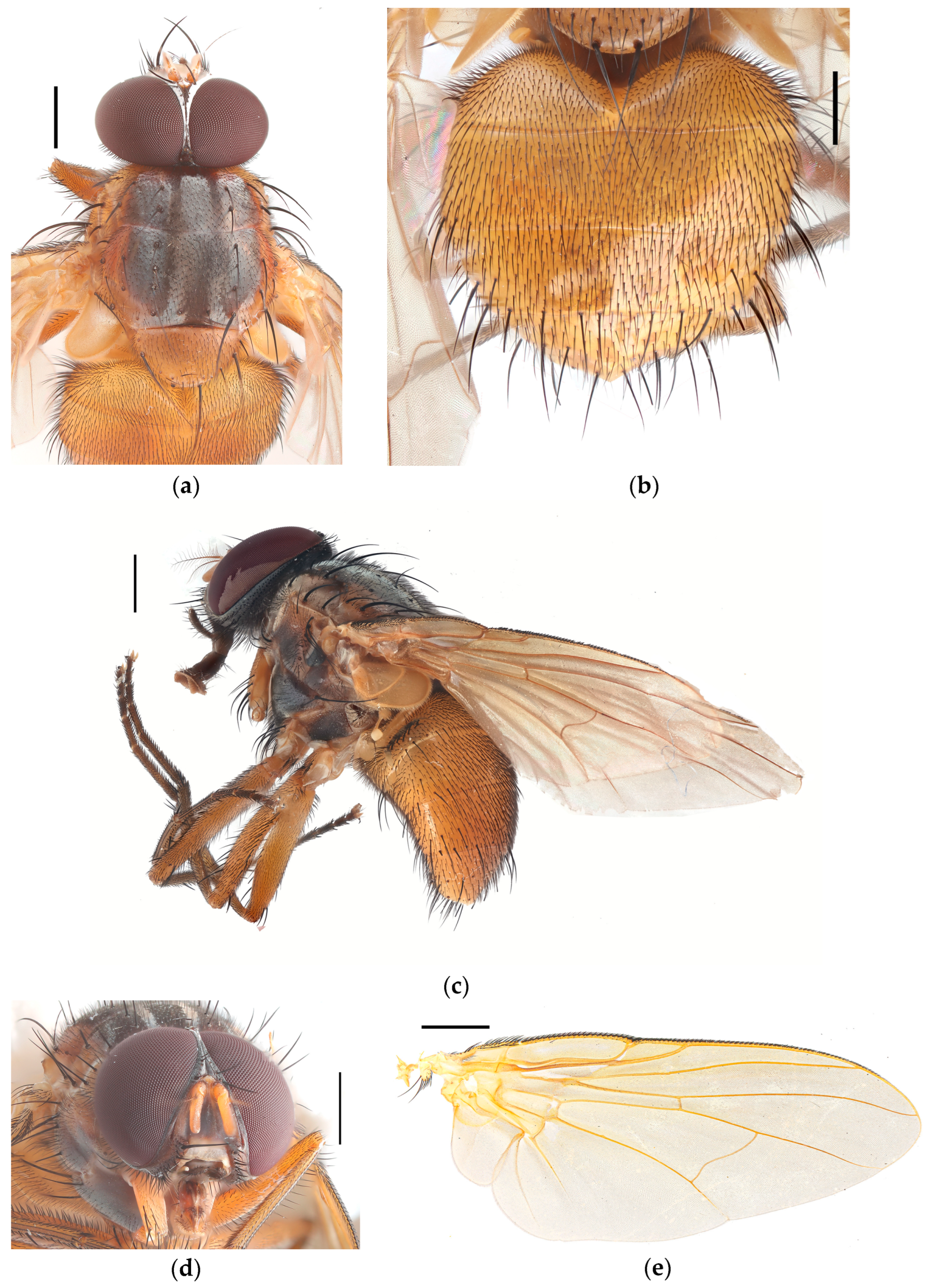
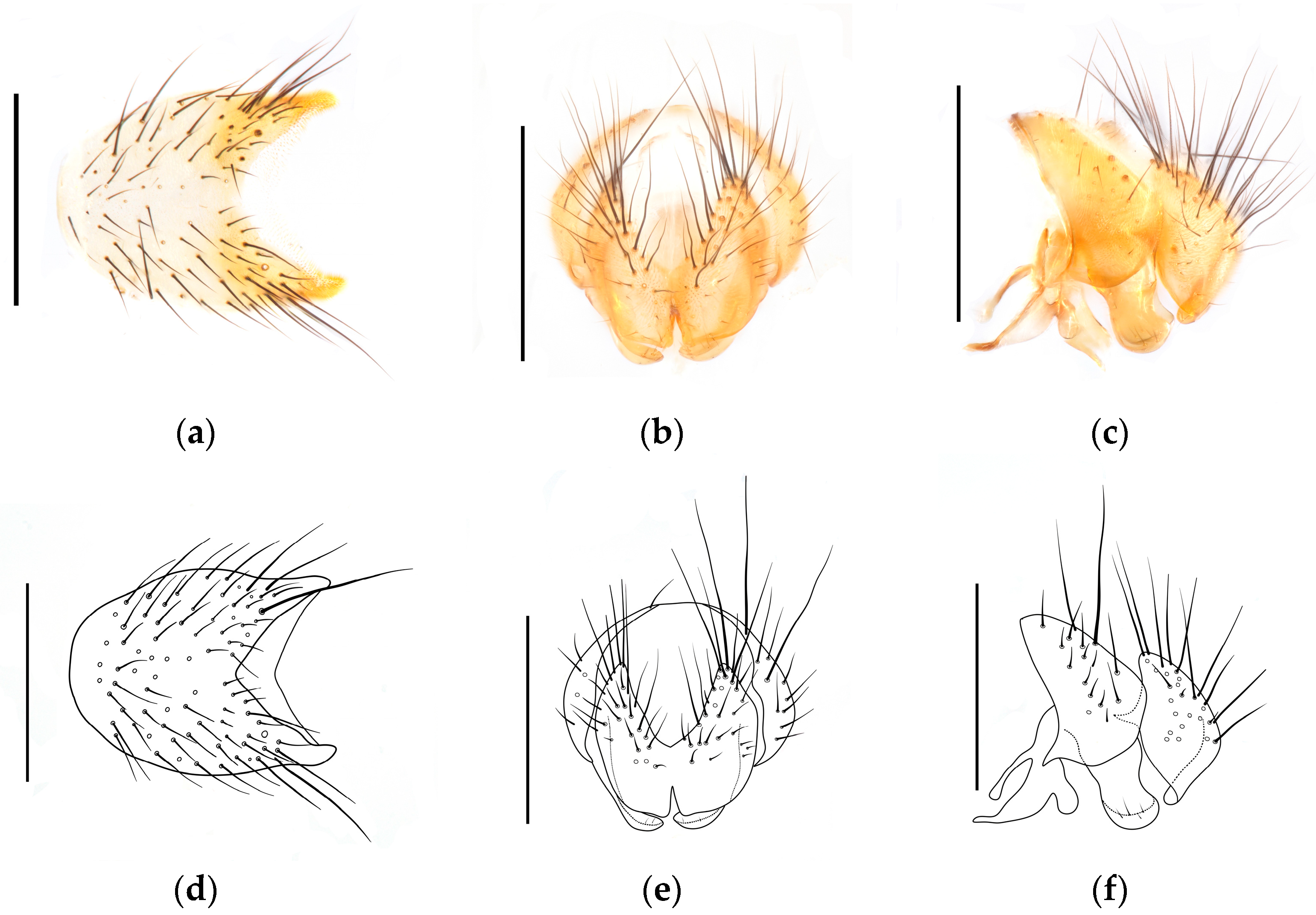
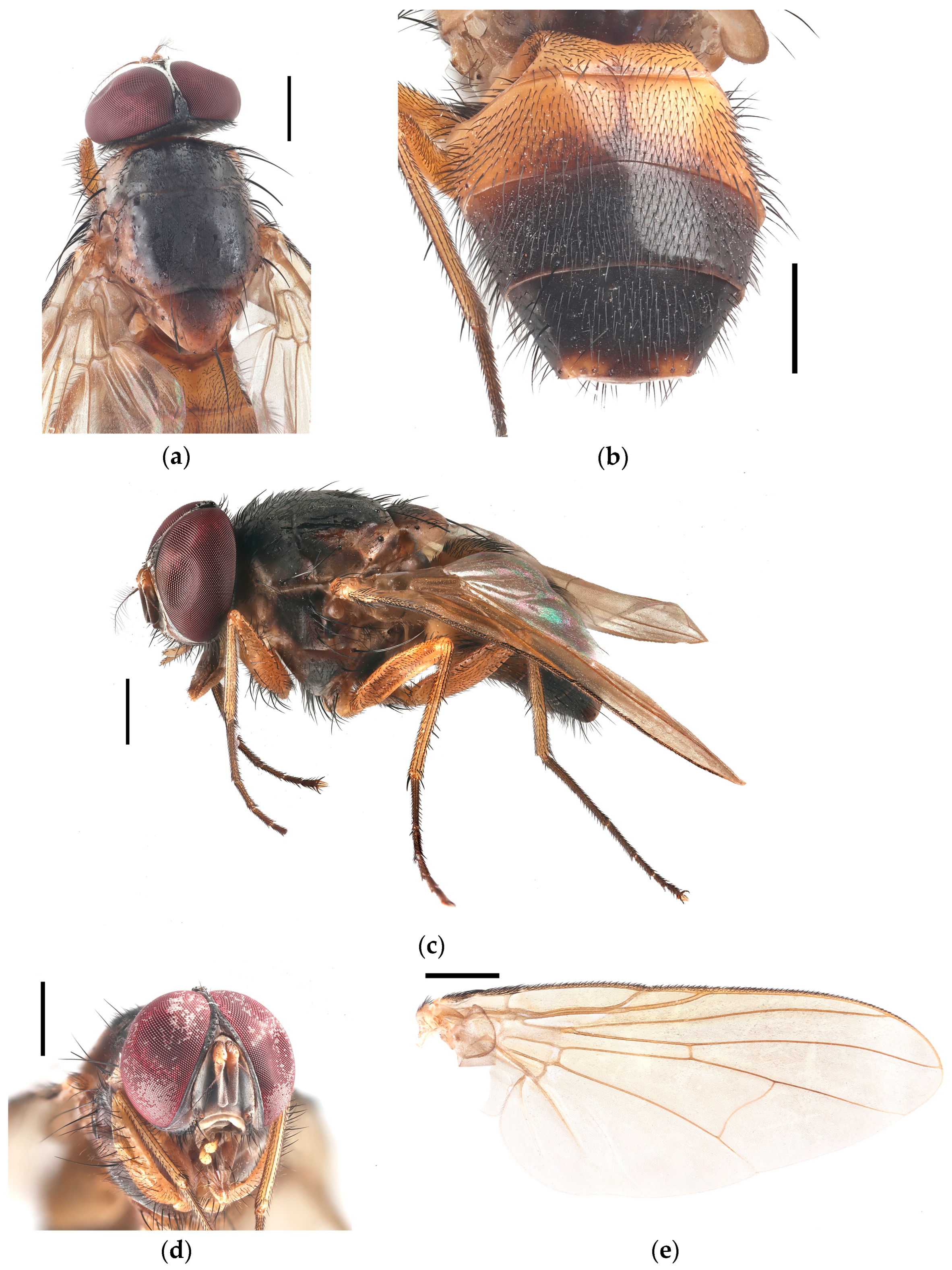

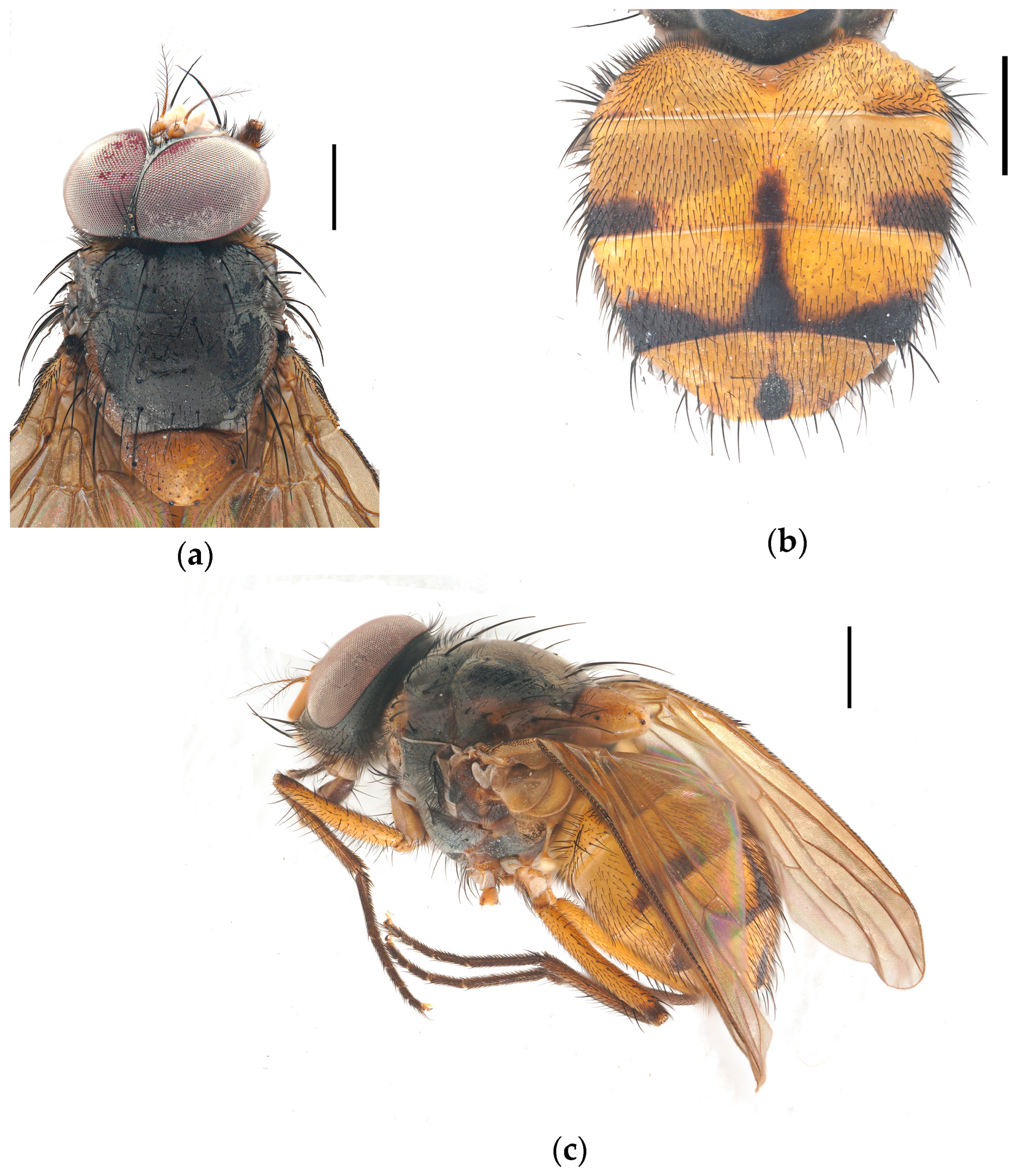

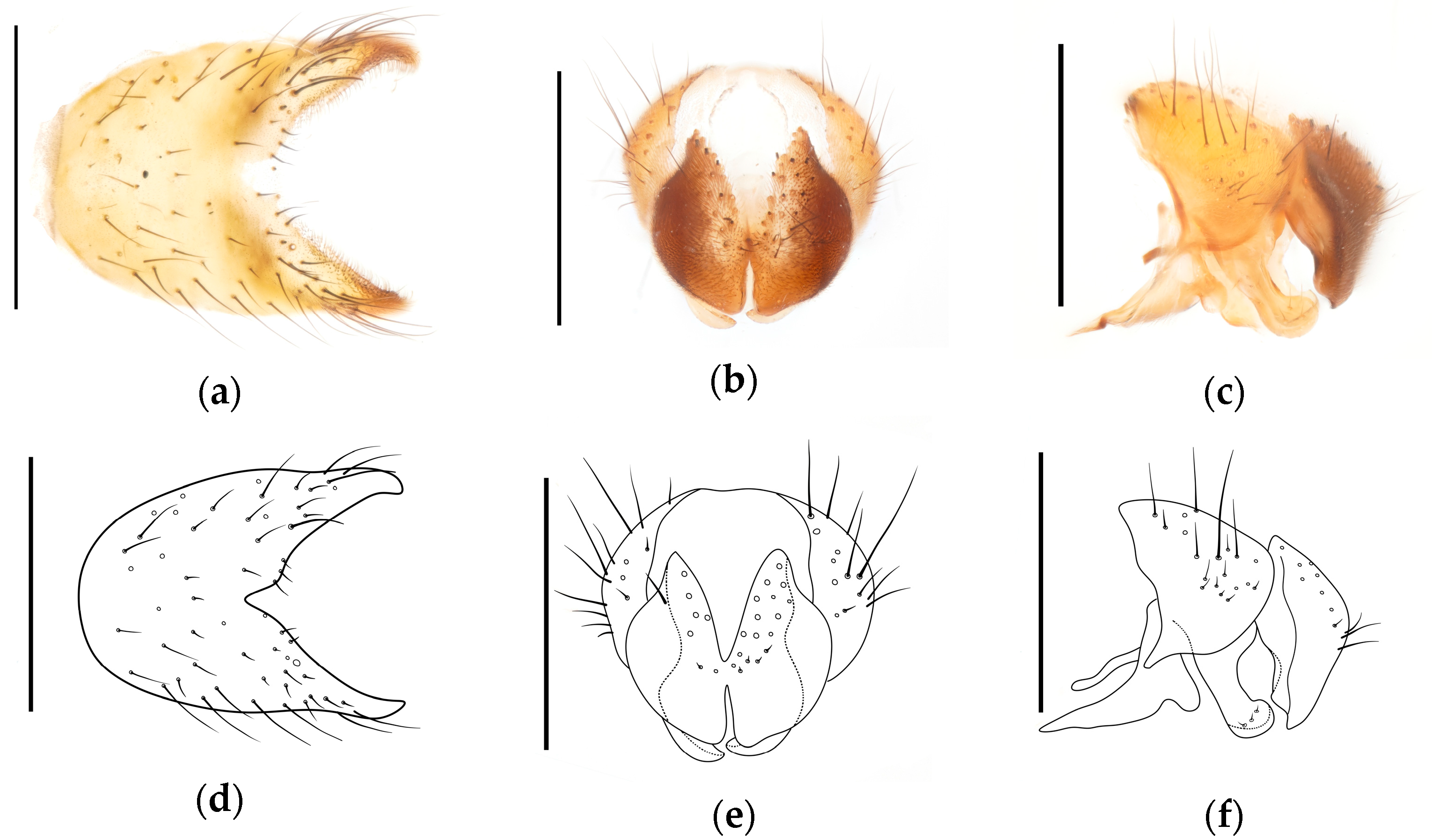
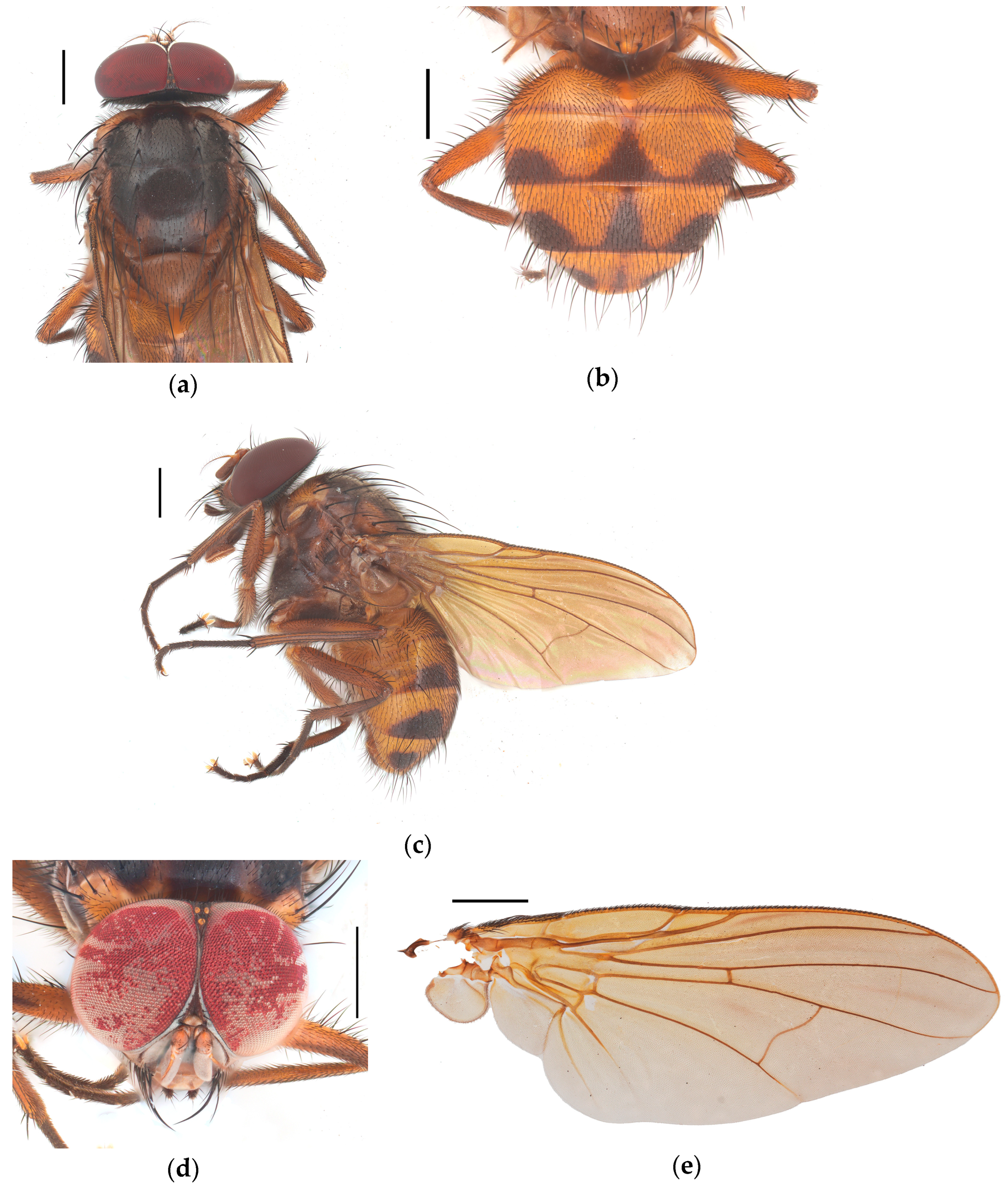
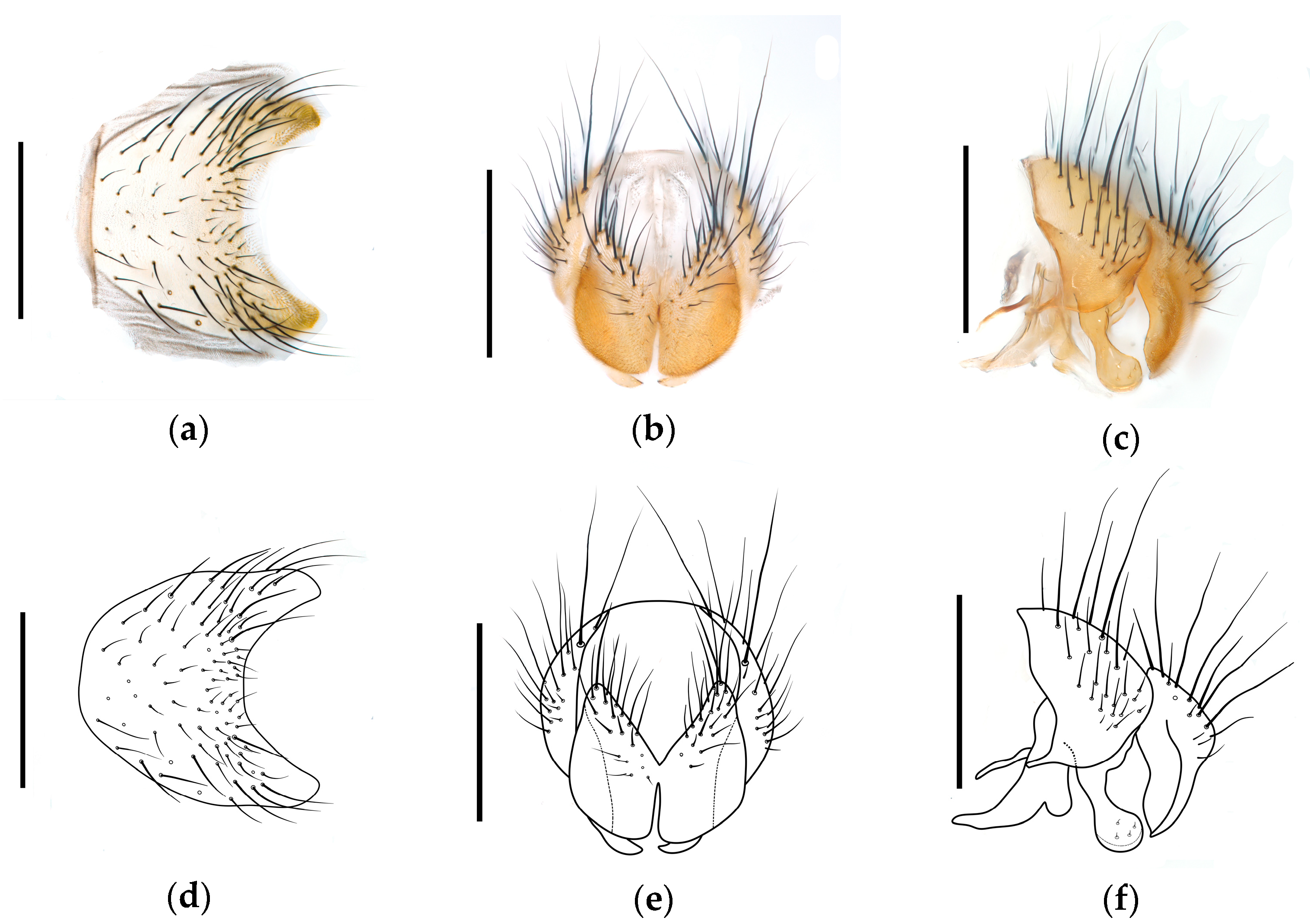

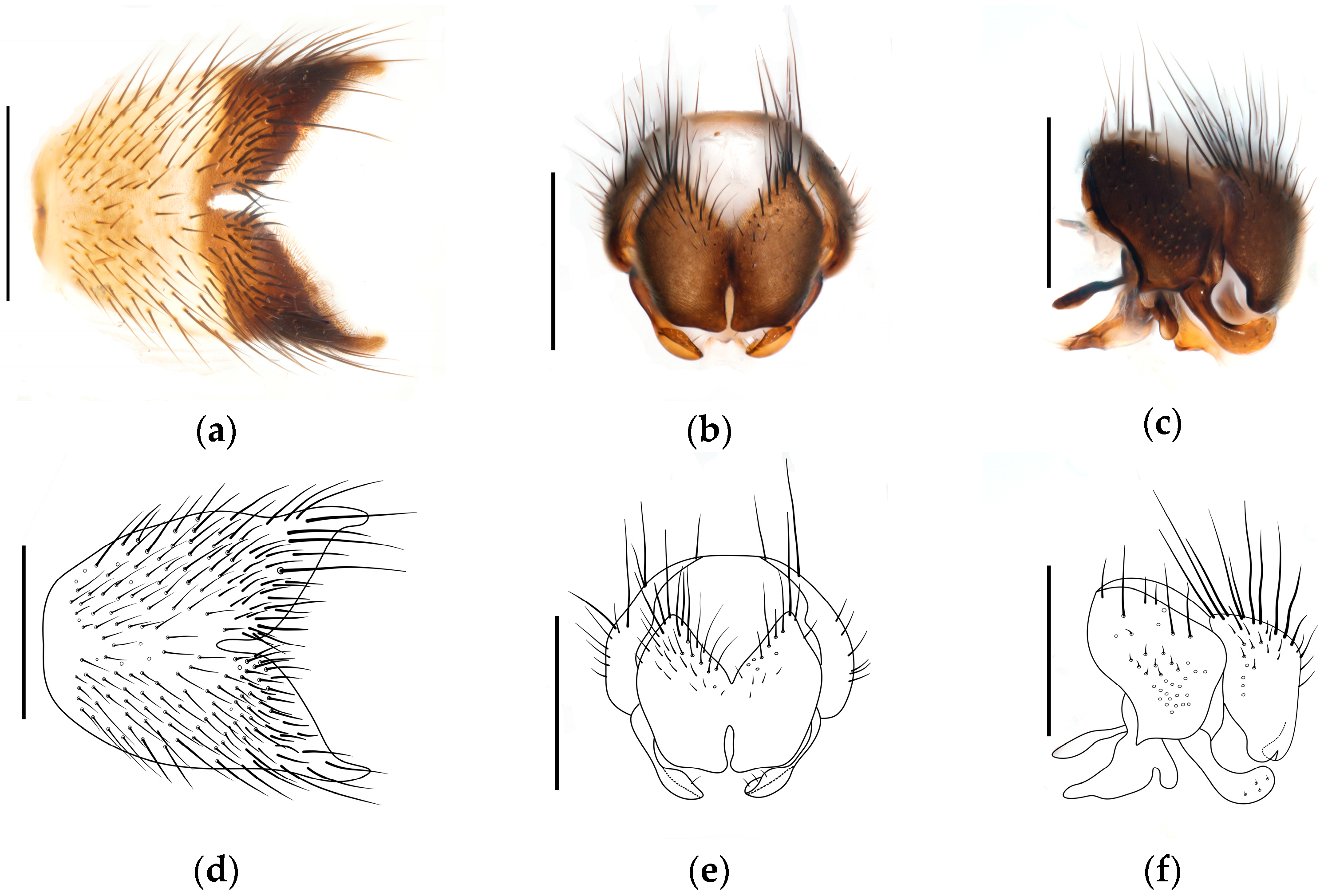
Disclaimer/Publisher’s Note: The statements, opinions and data contained in all publications are solely those of the individual author(s) and contributor(s) and not of MDPI and/or the editor(s). MDPI and/or the editor(s) disclaim responsibility for any injury to people or property resulting from any ideas, methods, instructions or products referred to in the content. |
© 2025 by the authors. Licensee MDPI, Basel, Switzerland. This article is an open access article distributed under the terms and conditions of the Creative Commons Attribution (CC BY) license (https://creativecommons.org/licenses/by/4.0/).
Share and Cite
Han, Y.; Li, W.; Yang, D. Three New and Two New Record Species of the Genus Dichaetomyia Malloch (Diptera: Muscidae) from China. Diversity 2025, 17, 232. https://doi.org/10.3390/d17040232
Han Y, Li W, Yang D. Three New and Two New Record Species of the Genus Dichaetomyia Malloch (Diptera: Muscidae) from China. Diversity. 2025; 17(4):232. https://doi.org/10.3390/d17040232
Chicago/Turabian StyleHan, Yizhen, Wenliang Li, and Ding Yang. 2025. "Three New and Two New Record Species of the Genus Dichaetomyia Malloch (Diptera: Muscidae) from China" Diversity 17, no. 4: 232. https://doi.org/10.3390/d17040232
APA StyleHan, Y., Li, W., & Yang, D. (2025). Three New and Two New Record Species of the Genus Dichaetomyia Malloch (Diptera: Muscidae) from China. Diversity, 17(4), 232. https://doi.org/10.3390/d17040232






